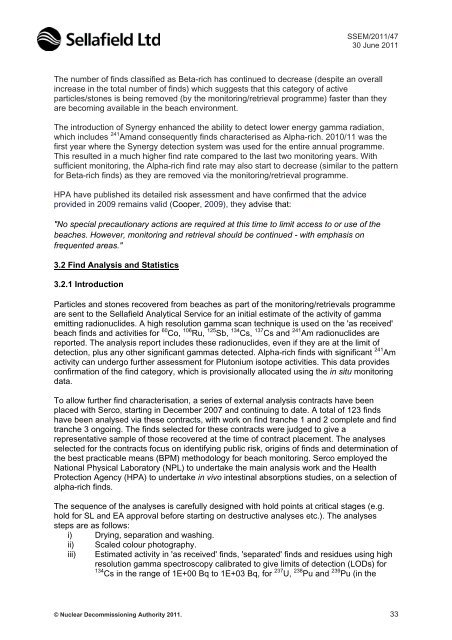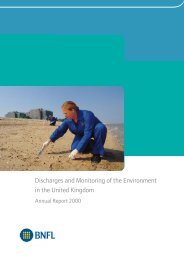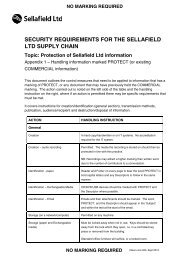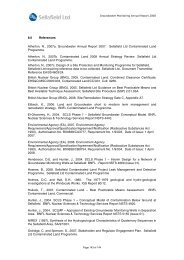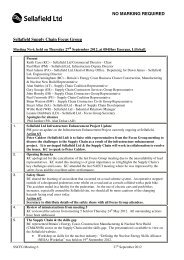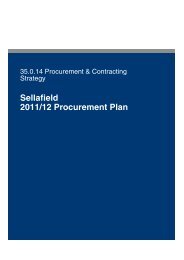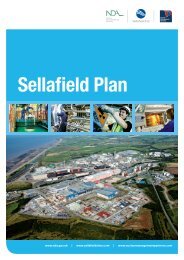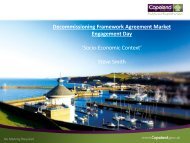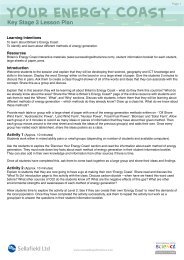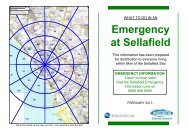Annual Report for 2010/11 and Forward Programme - Sellafield Ltd
Annual Report for 2010/11 and Forward Programme - Sellafield Ltd
Annual Report for 2010/11 and Forward Programme - Sellafield Ltd
Create successful ePaper yourself
Turn your PDF publications into a flip-book with our unique Google optimized e-Paper software.
SSEM/20<strong>11</strong>/4730 June 20<strong>11</strong>The number of finds classified as Beta-rich has continued to decrease (despite an overallincrease in the total number of finds) which suggests that this category of activeparticles/stones is being removed (by the monitoring/retrieval programme) faster than theyare becoming available in the beach environment.The introduction of Synergy enhanced the ability to detect lower energy gamma radiation,which includes 241 Am<strong>and</strong> consequently finds characterised as Alpha-rich. <strong>2010</strong>/<strong>11</strong> was thefirst year where the Synergy detection system was used <strong>for</strong> the entire annual programme.This resulted in a much higher find rate compared to the last two monitoring years. Withsufficient monitoring, the Alpha-rich find rate may also start to decrease (similar to the pattern<strong>for</strong> Beta-rich finds) as they are removed via the monitoring/retrieval programme.HPA have published its detailed risk assessment <strong>and</strong> have confirmed that the adviceprovided in 2009 remains valid (Cooper, 2009), they advise that:3.2 Find Analysis <strong>and</strong> Statistics3.2.1 IntroductionParticles <strong>and</strong> stones recovered from beaches as part of the monitoring/retrievals programmeare sent to the <strong>Sellafield</strong> Analytical Service <strong>for</strong> an initial estimate of the activity of gammaemitting radionuclides. A high resolution gamma scan technique is used on the 'as received'beach finds <strong>and</strong> activities <strong>for</strong> 60 Co, 106 Ru, 125 Sb, 134 Cs, 137 Cs <strong>and</strong> 241 Am radionuclides arereported. The analysis report includes these radionuclides, even if they are at the limit ofdetection, plus any other significant gammas detected. Alpha-rich finds with significant 241 Amactivity can undergo further assessment <strong>for</strong> Plutonium isotope activities. This data providesconfirmation of the find category, which is provisionally allocated using the monitoringdata.To allow further find characterisation, a series of external analysis contracts have beenplaced with Serco, starting in December 2007 <strong>and</strong> continuing to date. A total of 123 findshave been analysed via these contracts, with work on find tranche 1 <strong>and</strong> 2 complete <strong>and</strong> findtranche 3 ongoing. The finds selected <strong>for</strong> these contracts were judged to give arepresentative sample of those recovered at the time of contract placement. The analysesselected <strong>for</strong> the contracts focus on identifying public risk, origins of finds <strong>and</strong> determination ofthe best practicable means (BPM) methodology <strong>for</strong> beach monitoring. Serco employed theNational Physical Laboratory (NPL) to undertake the main analysis work <strong>and</strong> the HealthProtection Agency (HPA) to undertake intestinal absorptions studies, on a selection ofalpha-rich finds.The sequence of the analyses is carefully designed with hold points at critical stages (e.g.hold <strong>for</strong> SL <strong>and</strong> EA approval be<strong>for</strong>e starting on destructive analyses etc.). The analysessteps are as follows:i) Drying, separation <strong>and</strong> washing.ii)iii)Scaled colour photography.Estimated activity in 'as received' finds, 'separated' finds <strong>and</strong> residues using highresolution gamma spectroscopy calibrated to give limits of detection (LODs) <strong>for</strong>134 Cs in the range of 1E+00 Bq to 1E+03 Bq, <strong>for</strong> 237 U, 238 Pu <strong>and</strong> 239 Pu (in the© Nuclear Decommissioning Authority 20<strong>11</strong>. 33


